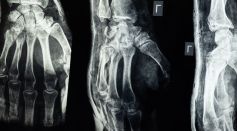Tags: Nanoparticles

Spray-On Technology Using Gold Nanoparticles Offers Therapeutic Potential for Cardiovascular Diseases

Nanocapsules for a More Effective Chemodynamic Therapy Developed for One-Step Cancer-Fighting Approach

Bleeding, Death from Traumatic Injuries May Be Prevented Using Nanoparticles

Efficacy of Intranasal Flu Vaccine with Nanoparticles Can Help in the Fight Against Influenza Virus

Colloidal Crystals: New Study Reveals Nanoparticles Can Be Programmed Through This Nanomaterial Type

New Type of Protection for Nanomedicines Against Immune System Attacks Developed

Male Nanocontraception: How Nanoparticles Can be Delivered to Testicles for Men’s Birth Control

Structural Blueprint of Nanoparticles Targeting Blood Cells That Cause Lung Inflammation Developed

New Approach to Store Hydrogen Using ‘Nano-Chocolates’ Method Introduced
Smart Transformable Nanoparticles Developed to Diagnose, Treat Tumor; Study Reveals Devising of Biomedical Nanomaterial
Photocatalysis: How Effective Is This New Approach to Optimize an Aerogel Made of TiO2 Nanoparticles?
Nanoparticles Within Life-Threatening Medications May Help Reduce Infusion Reactions
Scientists Use Nanoparticles to Kill Bacteria Hiding in Human Cells
Quantum Confinement in Nano-Photocatalyst: Hydrogen from Solar Water Splitting Contributes Its Production From Green Resources

Cooler Than Cotton: Research Team Develops Modified Silk Cloth That Keeps Temperature Cool Even Under Direct Sunlight
Fluorescent Nanomaterials Given an Eco-Friendly ‘Glow Up’ in a New Study
Color-Changing Indicator Combining Two Compounds Within Nanoparticles Predict Looming Algal Bloom
Biofilm-Forming Pathogens Contribute to Treatment of Infections; New Study Reveals How Nanosilver Killed 99 Percent of Bacterial Population

Particle Refinement Boosts Sodium/Lithium-Ion Batteries By Inducing and Increasing Cycle Capacity
Cancer Treatment: New Software Uses Artificial Intelligence to Grow, Treat Virtual Tumors
Most Popular

Recycling Myths vs Facts: What Actually Gets Recycled and How to Do It Right

What Is Conservation Biology? Key Strategies to Protect Species and Habitats

Allergies Explained: What Happens in Your Body During an Allergic Reaction

Types of Pollution: Air, Water, Soil, Noise, and Their Health Effects




